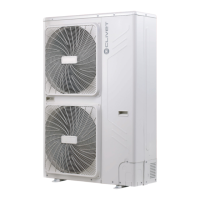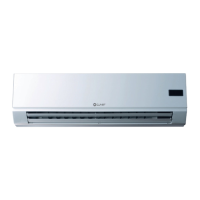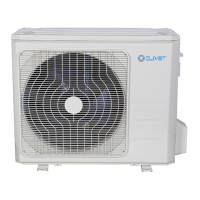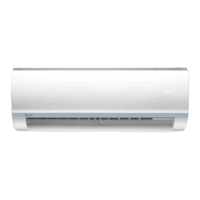40
Starting up the system
Example:
Initial room temperature (Ti) after charging with N2: 26°C
Nitrogen pressure (Pi) in the system at 26°C: 4.0 MPa
(40bar)
Final room temperature (Tf) after 24 hours: 18°C
Nitrogen pressure (expected) at final room temperature
(Tf) after 24 hours:
= 40 bar + (18°C-26°C) x 0.1bar/°C
= 40 bar - 0.6 bar
Pf = 39.4 bar
If the actual final pressure (Pf) is evidently lower than the
expected final pressure (Pf) (< 39.4 bar), there is a leak
that needs to be found.
– Perform vacuum drying. See paragraph “6.3
Vacuum operation” page 40
If drying cannot be carried out immediately, reduce the
pressure to 0.5-0.8MPa until drying is possible.
4
1
3
2
5
Fig. 64
In order to detect nitrogen leaks, proceed as follows:
– it is possible to hear a noise when there are
significant leaks;
– put your hands on the joints to feel for gas leaks;
– apply soapy water over the joints made. If bubbles
form, there are small leaks.
– check all the joints with a leak detector.
6.3 Vacuum operation
Perform drying to remove moisture and non-condensable
gases from the system. The elimination of moisture
prevents the formation of ice and the oxidation of copper
pipes or other internal components.
The presence of ice particles in the system could cause
malfunctions.
Oxidised copper particles can cause damage to the
compressor.
Non-condensable gases present in the system could
cause pressure fluctuations and lead to poor performance
of the heat exchanger.
The combination of a vacuum operation and a gas leak
test facilitates the detection of leaks.
m
CAUTION
Before vacuum drying, make sure that all the
stop valves of the outdoor unit are closed.
m
CAUTION
Use only one-way valves. Once the procedure
is complete and the pump stops, the low
pressure can draw the lubricant from the
pump into the system. The same situation
arises if the pump suddenly stops during the
procedure.
Mixing of the pump lubricant with the
compressor oil can cause the compressor to
malfunction.
To perform drying, a vacuum pump is used to lower
the pressure in the pipes until all the moisture present
evaporates.
It is necessary to use a vacuum pump capable of
maintaining a pressure
equal to or less than -756
mmHg (recommended vacuum level: <750mTorr) below
atmospheric pressure. At -755 mmHg below atmospheric
pressure, water reaches its boiling point at 0 °C.
We recommend using a vacuum pump with a discharge
rate greater than 4 litres/s and an accuracy level of 0.02
mmHg
To carry out the vacuum operation, proceed as follows:
– Connect a three-way pressure gauge (1) to the
gas pipe stop valve (2) of the main unit via the low
pressure pipe (B) and to the liquid pipe stop valve
(3) via the high pressure pipe (A) and to the vacuum
pump (4) via the vacuum refrigerant pipe (C).

